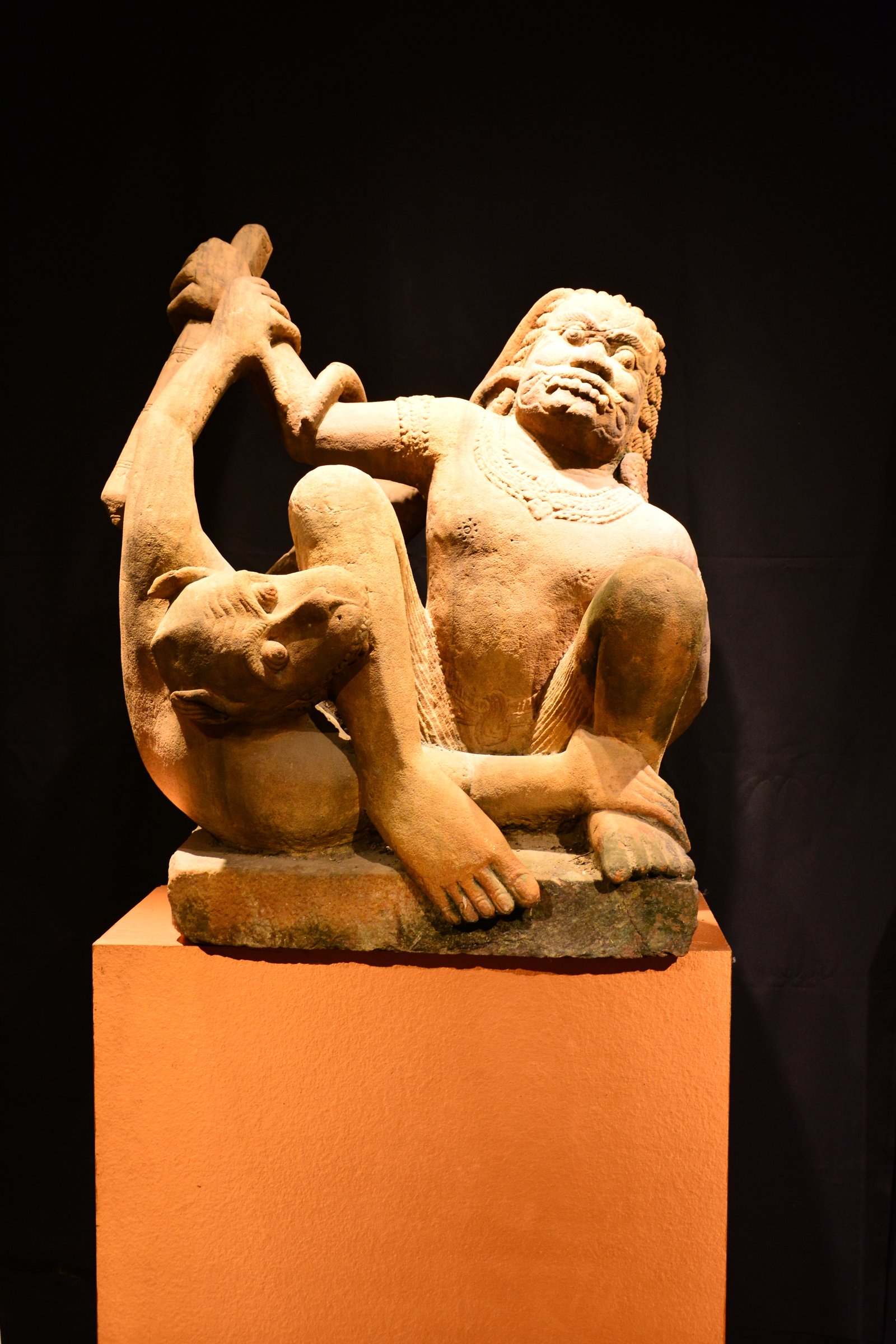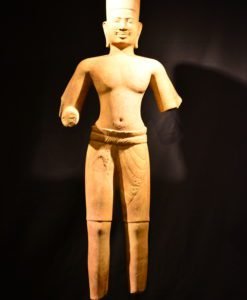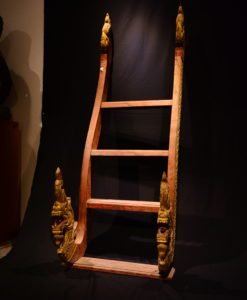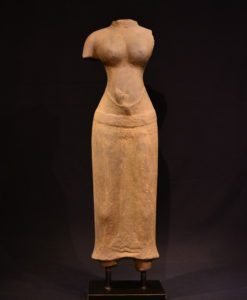Bayon Period Khmer Sandstone Sculpture of Hanuman Wrestling a Rakshasa – c. 12th–13th Century, Cambodia (83 x 83 x 83 cm)
This extraordinary sandstone sculpture, measuring approximately 83 x 83 x 83 cm, is a rare freestanding relic from the Bayon period of Khmer art, dated to the late 12th–early 13th century CE. Carved with profound narrative dynamism, it portrays a mythological wrestling duel—likely between Hanuman, the revered monkey general of the Reamker (the Cambodian adaptation of the Ramayana), and a Rakshasa or demon-giant. A moment frozen in battle, the sculpture encapsulates both the spiritual values and artistic vitality of Cambodia’s Angkorian zenith.
ITEM DESCRIPTION
A Legacy of Stone: Khmer Bayon Period in Context
The Bayon period—reigning under King Jayavarman VII—marks a pivotal era in Cambodian history when temple art reached new narrative sophistication. The Bayon temple itself is famed for its exuberant reliefs depicting divine battles, celestial processions, and scenes of everyday life. Within this cultural milieu, mythological combat became a medium of moral instruction. Hanuman, the embodiment of loyalty, discipline, and divine strength, frequently appears in narrative artworks as the champion of righteousness against chaos.
Stylization and Motion: A Deep Artistic Reading
This sculpture is an exceptional three-dimensional representation, not a relief or a fragment. The composition is fully rounded, meant to be admired from all sides, a rare trait in temple statuary. The figures are engaged in a spiraling struggle—Hanuman’s tail wraps around the Rakshasa’s arm, his teeth bite into the demon’s leg, and his posture, though grounded, is one of tactical control. The Rakshasa’s contorted form, club raised in futile defense, visually conveys defeat and anguish. This tactile interaction between the two bodies—one muscular and nimble, the other heavy and torqued—is carved in smooth, weathered Khmer sandstone, prized for its durability and grace.
The monkey figure’s facial expression is marked by intense determination, while the giant’s features—arched back, gritted teeth—evoke agony and spiritual imbalance. The demon wears neck and upper arm jewelry, stylized in Bayon aesthetics, suggesting his elite but corrupted status in mythic hierarchy. Notably, the club he holds is rendered in the smooth, blunt form distinctive of late-Angkorian sculpture, lacking ornamental spikes but resonating with symbolic authority.
Symbolism Beyond the Surface
While this scene may derive directly from the Reamker, it transcends mere illustration. In Khmer ideology, Hanuman’s wrestling match is more than a physical confrontation—it is the embodiment of dharma (cosmic order) subduing adharma (chaos). Wrestling scenes of this caliber were meant to inspire and instruct, especially in temple settings where morality and cosmic alignment were central teachings.
The free-standing base, a simple uncarved square, further emphasizes the statue’s purpose as an independent object of contemplation, possibly once displayed in a ceremonial niche or atop a plinth within a temple courtyard. The absence of surrounding narrative relief allows the viewer to focus entirely on the powerful gesture and internal drama of the two combatants.
Collector’s Perspective: Why This Piece Matters
For the seasoned collector of Southeast Asian art, this piece offers not only extraordinary visual appeal but also profound historical and philosophical significance. Few freestanding sculptures from the Bayon period survive in such evocative condition—free of major cracks, with balanced proportions, and an uncompromised narrative clarity. The stylized musculature, animated postures, and expressive detailing all point to the hand of an accomplished artisan working in the service of mythic retelling and temple ritual.
Its large size and vigorous pose make it ideal for display in a private collection, museum, or scholarly institution. More importantly, it is a testament to Khmer resilience and cultural sophistication, a sculptural parable of spiritual warfare and heroic triumph.
Conclusion: An Icon of Moral Combat and Khmer Mastery
This Bayon-period sandstone sculpture of Hanuman and a Rakshasa is more than a relic—it is a storytelling monument, carved in stone, enduring through centuries. It invites not only admiration but engagement, calling the viewer into the eternal struggle of light over shadow, virtue over vice. Owning such a piece is not merely acquiring art—it is preserving the legacy of Angkor’s mythic heart.
References:
-
Freeman, M. and Jacques, C. (2003). Ancient Angkor. Bangkok: River Books.
-
Jessup, H. (2004). Art and Architecture of Cambodia. London: Thames & Hudson.
-
Coedès, G. (1968). The Indianized States of Southeast Asia. Honolulu: University of Hawaii Press.
-
National Museum of Cambodia. (n.d.). Bayon Art and Iconography. [Online] Available at: https://www.museum.gov.kh
Origin: Cambodia
Period: Bayon Period 13th – 14th Century
PRODUCT DETAIL
Medium: Sandstone
Dimensions:
Height 83 cm
Length – cm
Wide 63 cm
Condition Report: –
Please keep in touch for Price and more information: Mallika1013@gmail.com




















